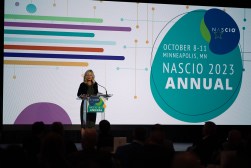State, local CIOs changing ‘smart’ projects to better engage employees

SALT LAKE CITY — As state and local governments try to get smarter, chief information officers believe they need to change how they manage their IT staff to achieve results more quickly and build momentum.
With the constant change that comes in IT leadership in cities and states due to the frequency of elections, CIOs stressed the importance of setting frequent project benchmarks at a panel discussion here at the National Association of State Chief Information Officers’ annual conference.
“The leadership that sets the vision for these ‘smart state’ projects, that keeps changing,” Illinois CIO Hardik Bhatt said. “But the middle management doesn’t change. They say, ‘We were here for the old vision, now we have this new one.’ There’s a fundamental disconnect.”
Salt Lake City CIO Bill Haight added that his city frequently sees a burst in productivity toward developing “smart city” projects when a new administration comes in, but six months before any election, momentum tends to slow. He attributes that shift to middle management in the IT department growing tired of the constant change in policies, and assuming they can simply “outlast” any new initiative.
“We need to shorten the timeframe in order to drive innovation and decision-making processes around smart technology,” Haight said.
In response to that sort of apathy, Bhatt said he’s made some changes in Illinois over the course of his seven months on the job. Now, every new “smart state” project his staff embarks on is broken into measurable goals over 75-day chunks, whether they’re short-term efforts or part of his broader strategic vision for the state.
It’s an ethos that Bhatt colorfully communicates to his staff by insisting that while they’re “on the way to robbing the bank, rob some gas stations.”
“We can start getting buy-in with this,” Bhatt said. “We say, ‘This is what we’re trying to do with [return on investment] for taxpayers,’ so even with changes at the top, they’ll start getting bought in.”
As part of the process of engaging the state’s IT staff, Bhatt also noted that they’re offering increased training opportunities for employees to help them feel more prepared to work on projects involving the Internet of Things or mobile technology.
To help more experienced employees “not feel threatened” by younger workers, Bhatt said that his state is now working with community colleges and universities in the state’s capital of Springfield to offer programs to get new training on major technology changes coming down the line.
“We tell them, ‘Now you have the ability to re-skill yourself, now you’re able to be competitive,” Bhatt said.
Haight said Salt Lake City also offers some limited internal training programs, but budget constraints limit his abilities to offer formal classes. Instead, he works to get his employees outside of their comfort zones to get them engaged with new technologies.
“We give them the opportunity to work on projects that wouldn’t normally be part of their day-to-day responsibilities and give them the chance to explore a little,” Haight said.
As Salt Lake City moves to consolidate its IT operation under Haight’s Information Management Services department, the CIO believes that type of increased knowledge base will be key as the city centralizes all its projects.
“It makes no sense for me for each department to have an IT department within that and each department to operate its individual systems,” Haight said. “You don’t have to have centralized enterprise systems across this, but the data does have to be centralized.”
Bhatt agreed with the importance of keeping data in one place, particularly as citizens demand more and more information about how the government functions as part of the move to a “smarter state.”
“We are so siloed right now and we have to move the pendulum the other way,” Bhatt said. “We have to structurally transform how we run the business of government.”





